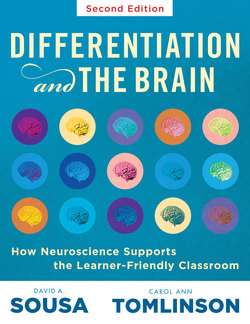Читать книгу Differentiation and the Brain - David A. Sousa - Страница 4
На сайте Литреса книга снята с продажи.
ОглавлениеTable of Contents
Reproducible pages are in italics.
About the Authors
Introduction
How Brain Friendly Is Differentiation?
The Rise, Fall, and Rise of Differentiation
About This Book
Questions This Book Will Answer
Chapter Contents
Other Helpful Tools
1 The Nonnegotiables of Effective Differentiation
A Focus on Learners
A Model for Effective Differentiation
Brain Research and Differentiation
Differentiation in a Nutshell
2 Mindset, Learning Environment, and Differentiation
What Are Mindsets?
The Effective Teacher’s Mindset
Teachers Have a Lifelong Impact
The Classroom Must Feel Safe and Secure
All Students Want to Succeed
Teachers Must Meet the Social-Emotional Needs of Students
Technology Is Affecting Social Skills
Empathy Is Very Important
Students Should Feel a Sense of Ownership of Their Education
Teachers Should Identify and Reinforce Each Student’s Areas of Competence
Teachers Should Address Fears of Failure and Humiliation
Discipline Is a Teaching Process
Fixed and Growth Mindsets
Mindset, Teaching, and Learning
Fixed and Growth Mindsets and Differentiation
Classroom Environments and Differentiation
Learning Environments, Student Affect, and Differentiation
Learning Environments, Student Cognition, and Differentiation
Exercise 2.1
Questions for Teachers About Mindset, Learning Environment, and Differentiation
Exercise 2.2
Questions for Teachers About Student Affective Needs, Learning Environment, and Differentiation
Exercise 2.3
Reflections on Cognitive Traits of Learners and the Environments That Support Those Traits
Exercise 2.4
Questions for Teachers About Student Cognitive Needs, Learning Environment, and Differentiation
3 Curriculum and Differentiation
The Importance of a Quality Curriculum
Quality Curriculum Is Organized Around Essential Content Goals
Curriculum Races Are Not Brain Friendly
Specificity Is Important
Quality Curriculum Is Aligned
Quality Curriculum Focuses on Student Understanding
Learning Tasks Should Extend Understandings
Understandings Build Neural Networks
Different Pathways Lead to Common Goals
Quality Curriculum Engages Students
Quality Curriculum Is Authentic
Quality Curriculum Is Effectively Differentiated
Exercise 3.1
Questions for Teachers About the Quality of a Curriculum Unit
4 Classroom Assessment and Differentiation
Baggage From the Past: Negative Images of Classroom Assessment
Testing and Stress
Stress and Recall
Stress and Timed Tests
A More Productive View of Assessment
Purposes of Classroom Assessments
Assessment of Learning
Assessment for Learning
Assessment as Learning
Assessment and Differentiation
Grading and Differentiation
The Importance of Clear Goals
Exercise 4.1
Questions for Teachers to Ask to Determine Whether an Assessment Is Effective
5 Differentiating in Response to Student Readiness
Readiness Versus Ability
Why Addressing Readiness Matters
The Challenge of ZPD in the Classroom
Support From Neuroscience
Bridge Building
The Role of Classroom Elements in Planning for Readiness Differentiation
Learning Environment
Curriculum
Instruction
Assessment
Classroom Management
Some Guidelines for Differentiating in Response to Student Readiness
Content, Process, and Product Differentiation Based on Student Readiness
Content
Process
Product
Learning Contracts and Tiering for Differentiation
Learning Contracts
Tiering
Exercise 5.1
Questions for Teachers About Differentiating Instruction Based on Student Readiness
Exercise 5.2
Activities for Differentiating Content, Process, and Product Based on Student Readiness
6 Differentiating in Response to Student Interest
Attend to Student Interest
Why Student Interests Matter
Neuroscience and Interest
Seven Themes for Addressing Student Interest in the Classroom
The Role of Classroom Elements in Planning for Interest-Based Differentiation
Learning Environment
Curriculum
Assessment
Classroom Management
Guidelines for Differentiating in Response to Student Interest
Guidelines for Differentiating Content, Process, and Product Based on Student Interest
Content
Process
Product
Guidelines for Differentiating With Expert Groups and Sidebar Studies
Expert Groups
Sidebar Studies
Exercise 6.1
Questions for Teachers About Differentiating Instruction Based on Student Interest
Exercise 6.2
Activities for Differentiating Content, Process, and Product Based on Student Interest
7 Differentiating in Response to Student Learning Profile
The Aspects of Learning Profile
Learning Styles
Intelligence Preferences
Culture
Gender
Learning Profile: An Evolving Concept
What Neuroscience Research Says About Learning Profile
What a Learning Profile Should and Shouldn’t Mean
Some Guidelines for Differentiating in Response to Learning Profile
Differentiate Content, Process, and Product Based on Learning Profile
Content
Process
Product
Differentiate With Synthesis Groups and Thinking Caps
Synthesis Groups
Thinking Caps
An Additional Thought
Exercise 7.1
Questions for Teachers About Differentiating Instruction Based on Student Learning Profile
8 Managing a Differentiated Classroom
A Common View of Classroom Management
An Alternative View of Classroom Management
Eight Principles of Leading Students
Beginning to Lead
Helping Students Examine Their Learning Differences
Graphing Strengths
Trying It on for Size
Visiting the Doctor
Making Paper People
Helping Students Think About Differentiation
Some Guidelines for Managing a Differentiated Classroom
Use Anchor Activities
Consider Using Assigned or Home-Base Seats
Set Basic Parameters
Develop Methods for Assigning Students to Groups
Develop Methods for Giving Directions for Multiple Tasks
Develop Procedures for Students to Get Help When the Teacher Is Busy
Leading and Managing Successfully
Exercise 8.1
Some Guidelines to Ensure Effective Group Work
Epilogue
References and Resources
Index
